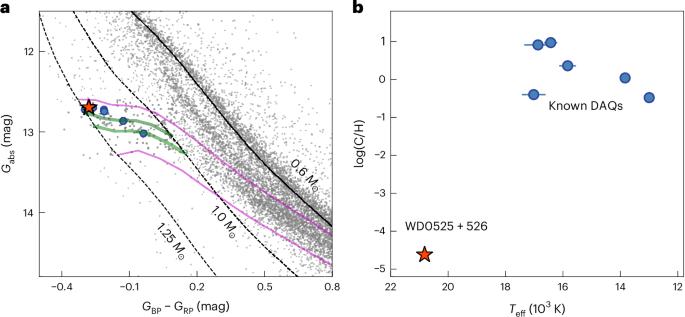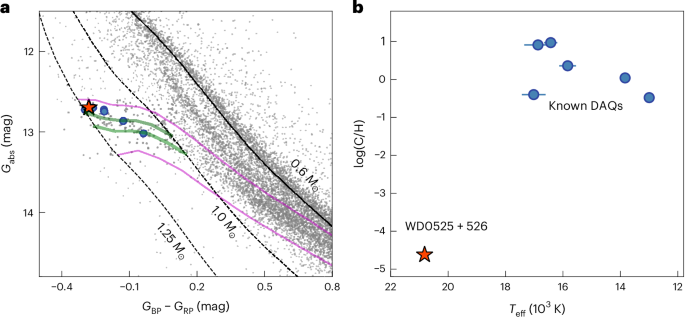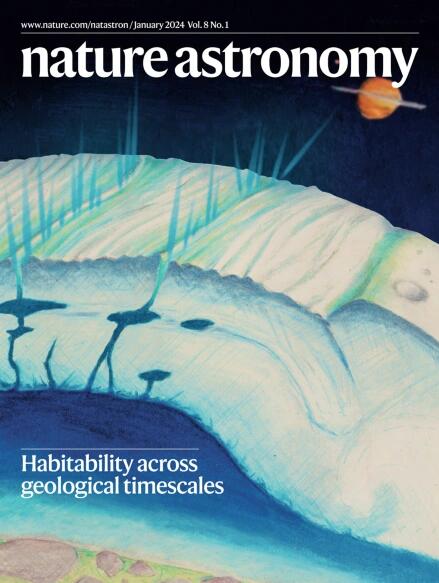一颗炽热的白矮星合并后的残余物,通过紫外探测发现了碳
IF 14.3
1区 物理与天体物理
Q1 ASTRONOMY & ASTROPHYSICS
引用次数: 0
摘要
在6颗富氢的超大质量白矮星的光谱中检测到大气中的碳,显示出巨大的碳丰度(log(C/H) >−0.5),这可归因于内部碳被对流吸收到薄的氢表面层。这些罕见的白矮星可能起源于恒星合并,使它们成为导致热核超新星的双星演化通道之一的“确凿证据”。然而,光谱学只能发现最富碳的物体,这表明更多的合并残留物可能伪装成正常的纯氢大气白矮星。在这里,我们报告哈勃太空望远镜在WD 0525+526的远紫外光谱中发现了大气中的碳,WD 0525+526是一颗众所周知的富氢超大质量白矮星。碳丰度(log(C/H) = - 4.62)比六个对应的低4-5个指数,因此只能在紫外线波长下检测到。我们发现包层中氢和氦的总质量(分别为白矮星总质量的10−13.8和10−12.6)大大低于单星演化的预期,这意味着WD 0525+526是合并遗迹。我们的模型显示,表面碳丰度低的原因是一种包膜结构,在这种结构中,一层薄薄的富氢层漂浮在半对流区之上,这一过程在白矮星中基本上被忽视了。我们的研究强调了紫外光谱在识别和表征合并残留物中的重要性。本文章由计算机程序翻译,如有差异,请以英文原文为准。


A hot white dwarf merger remnant revealed by an ultraviolet detection of carbon
Atmospheric carbon has been detected in the optical spectra of six hydrogen-rich ultra-massive white dwarfs, revealing large carbon abundances (log(C/H) > −0.5) attributable to the convective dredge-up of internal carbon into thin hydrogen surface layers. These rare white dwarfs likely originate from stellar mergers, making them ‘smoking guns’ for one of the binary evolution channels leading to thermonuclear supernovae. However, optical spectroscopy can uncover only the most carbon-enriched objects, suggesting that many more merger remnants may masquerade as normal pure-hydrogen-atmosphere white dwarfs. Here we report the discovery of atmospheric carbon in a Hubble Space Telescope far-ultraviolet spectrum of WD 0525+526, a long-known hydrogen-rich ultra-massive white dwarf. The carbon abundance (log(C/H) = −4.62) is 4–5 dex lower than in the six counterparts and thus detectable only at ultraviolet wavelengths. We find that the total masses of hydrogen and helium in the envelope (10−13.8 and 10−12.6 of the total white dwarf mass, respectively) are substantially lower than those expected from single-star evolution, implying that WD 0525+526 is a merger remnant. Our modelling indicates that the low surface carbon abundance arises from an envelope structure in which a thin hydrogen-rich layer floats atop a semi-convection zone—a process that has been largely overlooked in white dwarfs. Our study highlights the importance of ultraviolet spectroscopy in identifying and characterizing merger remnants. Ultraviolet observations of an ultra-massive white dwarf with the Hubble Space Telescope reveal small amounts of carbon on the surface, identifying it as a merger remnant.
求助全文
通过发布文献求助,成功后即可免费获取论文全文。
去求助
来源期刊

Nature Astronomy
Physics and Astronomy-Astronomy and Astrophysics
CiteScore
19.50
自引率
2.80%
发文量
252
期刊介绍:
Nature Astronomy, the oldest science, has played a significant role in the history of Nature. Throughout the years, pioneering discoveries such as the first quasar, exoplanet, and understanding of spiral nebulae have been reported in the journal. With the introduction of Nature Astronomy, the field now receives expanded coverage, welcoming research in astronomy, astrophysics, and planetary science. The primary objective is to encourage closer collaboration among researchers in these related areas.
Similar to other journals under the Nature brand, Nature Astronomy boasts a devoted team of professional editors, ensuring fairness and rigorous peer-review processes. The journal maintains high standards in copy-editing and production, ensuring timely publication and editorial independence.
In addition to original research, Nature Astronomy publishes a wide range of content, including Comments, Reviews, News and Views, Features, and Correspondence. This diverse collection covers various disciplines within astronomy and includes contributions from a diverse range of voices.
 求助内容:
求助内容: 应助结果提醒方式:
应助结果提醒方式:


